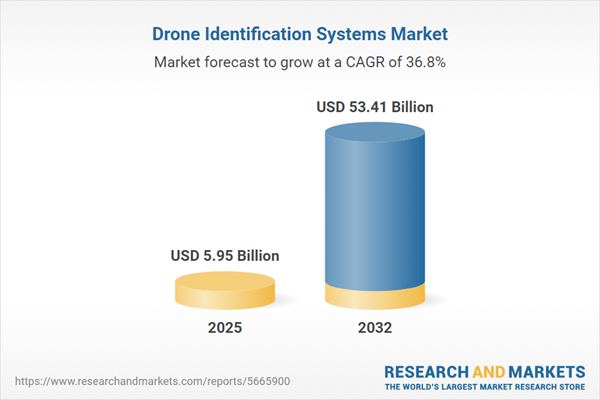Speak directly to the analyst to clarify any post sales queries you may have.
The drone identification systems market is evolving rapidly, driven by the convergence of advanced technologies, expanding operational scenarios, and heightened regulatory and security requirements. Senior decision-makers across sectors are now seeking a unified overview that distills key market dynamics and actionable strategies to inform critical investments and competitive positioning.
Market Snapshot: Drone Identification Systems Market Growth and Trajectory
The Drone Identification Systems Market grew from USD 4.35 billion in 2024 to USD 5.95 billion in 2025 and is projected to reach USD 53.41 billion at a 36.81% CAGR by 2032.
This strong expansion reflects escalating security needs and investments in both commercial and defense applications. Market growth is shaped by evolving airspace management approaches, regulatory mandates, and rising deployments across diverse environments, from metropolitan areas to critical infrastructure sites worldwide.Scope & Segmentation
This comprehensive study covers multi-dimensional segmentation across technologies, components, applications, end users, platforms, geographies, and leading companies:
- Technology
- Computer vision for automated classification and recognition
- Electro-optical/infrared sensors for day-night monitoring
- Lidar for precise spatial detection
- Radar solutions for adverse weather and environmental performance
- RF signal analysis to monitor device communication
- Component
- Hardware: processors for high-speed computation, sensors for versatile detection
- Services: integration, maintenance, and operator training suite
- Software: analytics for data fusion, device firmware, and middleware
- Application
- Border security
- Critical infrastructure protection
- Search and rescue missions
- Ongoing surveillance and monitoring
- Traffic management for aerial deconfliction
- Wildlife monitoring initiatives
- End User
- Commercial enterprises
- Conservation agencies
- Defense organizations
- Emergency services
- Infrastructure operators
- Law enforcement units
- Platform
- Ground-based installations with fixed arrays
- Manned aerial solutions for mobile coverage
- UAV-mounted systems for airborne flexibility
- Geographies
- Americas: North America (United States, Canada, Mexico), Latin America (Brazil, Argentina, Chile, Colombia, Peru)
- Europe, Middle East & Africa: extensive European and regional markets
- Asia-Pacific: extensive coverage of East and Southeast Asian economies
- Leading Companies
- SZ DJI Technology Co., Ltd.
- Dedrone Inc.
- DroneShield Ltd.
- Thales S.A.
- Hensoldt AG
- Leonardo S.p.A.
- Raytheon Technologies Corporation
- Lockheed Martin Corporation
- Northrop Grumman Corporation
- Elbit Systems Ltd.
Key Takeaways: Strategic Insights from the Drone Identification Systems Market
- The convergence of multiple sensor modalities and AI-powered analytics is enabling rapid, precise detection and identification, supporting real-time operational decisions in both public safety and defense settings.
- Stakeholders are prioritizing modular and platform-agnostic architectures, simplifying integration with command-and-control infrastructure and expanding deployment opportunities across urban, rural, and border environments.
- Collaborative vendor ecosystems, involving sensor technology specialists, software providers, and system integrators, are streamlining deployments and advancing predictive threat modeling and autonomous countermeasure capabilities.
- Customer needs are broadening to include not just procurement flexibility but robust lifecycle management, proactive maintenance, and outcome-based service models, shifting the competitive landscape toward service innovation as well as technology leadership.
- Emerging use cases in smart cities, conservation, and aerial traffic management continue to diversify market demand, while regulatory engagement remains essential for future-ready product strategies.
Tariff Impact: US Tariffs Reshaping Supply Chains
New U.S. tariffs on critical drone identification system components have driven up procurement costs and reconfigured supply chain strategies. Sector leaders are reducing exposure by sourcing domestically and establishing regional manufacturing hubs. This is accelerating the adoption of just-in-time inventory models, strategic supply partnerships, and alternative commercial frameworks, such as subscription-based and performance-driven service agreements, to contain costs and safeguard operational continuity.
Methodology & Data Sources
The report’s mixed-method approach includes in-depth secondary research, analysis of technical documentation, and structured interviews with system integrators, technology providers, regulators, and end users. Data triangulation and validation sessions with industry experts ensure the reliability and actionable relevance of findings.
Why This Report Matters
- Offers an authoritative benchmark to gauge technology investment priorities and mitigate supply chain risks in a volatile regulatory climate.
- Delivers segment-specific insights and competitive analysis to inform strategy, procurement, and partnership decisions across market stakeholders.
- Equips leadership teams to anticipate evolving operational, compliance, and integration requirements for future-proof drone identification solutions.
Conclusion
This report consolidates the key drivers, leading players, and technological advancements shaping the global drone identification systems landscape. Executives gain a strategic resource to confidently plan investments, navigate market complexities, and achieve sustained growth.
Additional Product Information:
- Purchase of this report includes 1 year online access with quarterly updates.
- This report can be updated on request. Please contact our Customer Experience team using the Ask a Question widget on our website.
Table of Contents
3. Executive Summary
4. Market Overview
7. Cumulative Impact of Artificial Intelligence 2025
List of Figures
Companies Mentioned
The companies profiled in this Drone Identification Systems market report include:- SZ DJI Technology Co., Ltd.
- Dedrone Inc.
- DroneShield Ltd.
- Thales S.A.
- Hensoldt AG
- Leonardo S.p.A.
- Raytheon Technologies Corporation
- Lockheed Martin Corporation
- Northrop Grumman Corporation
- Elbit Systems Ltd.
Table Information
| Report Attribute | Details |
|---|---|
| No. of Pages | 184 |
| Published | October 2025 |
| Forecast Period | 2025 - 2032 |
| Estimated Market Value ( USD | $ 5.95 Billion |
| Forecasted Market Value ( USD | $ 53.41 Billion |
| Compound Annual Growth Rate | 36.8% |
| Regions Covered | Global |
| No. of Companies Mentioned | 11 |









